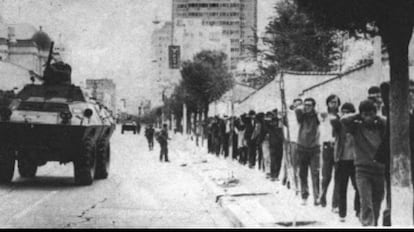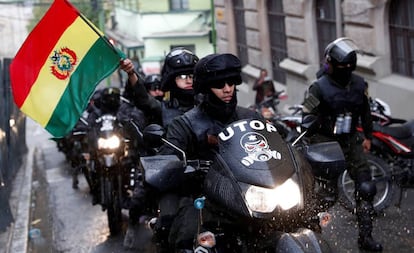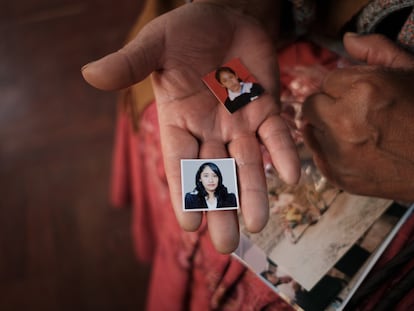Coups, riots and insurrections: Bolivia, a political volcano in constant eruption
The Andean-Amazonian country has suffered the most coups d’état in the world since 1950. Wednesday’s short-lived attempt is the latest episode in its turbulent history

The former Presidential Palace of Bolivia — which on Wednesday was violently stormed by a group of rebel soldiers, led by the now-dismissed head of the Army, Juan José Zúñiga — is called the Palacio Quemado, or Burnt Palace. The nickname comes from the 1875 coup, when a mob threw lit torches from the nearby cathedral and caused a fire that disabled the seat of government. The building, in Plaza Murillo in La Paz, was rebuilt. But since then, it has witnessed dozens of violent mobilizations, uprisings and coups d’état that have marked its history.
The last of these episodes occurred on Wednesday. In the Casa Grande del Pueblo — the modern skyscraper next to the Palacio Quemado that was built during the Evo Morales administration to be the seat of government — Bolivian President Luis Arce, surrounded by his Cabinet, called on the Bolivian people to mobilize to “confront any coup attempt.” Then he appointed a new military leadership and the rebel soldiers retreated. It was a day that will go down as another chapter in Bolivia’s long history of political instability.
According to a data analysis by U.S. academics Jonathan Powell and Clayton Thyne, Bolivia is the country that has suffered the most coups d’état in the world since 1950: 23 in total, although 12 of them failed. “Depending on how it is counted, there are an extraordinary number of coups d’état,” acknowledges Bolivian historian and journalist Robert Brockmann. “If it is by number of presidents, you can’t really take them all into account because some lasted half an hour,” he jokes.
In the period of military dictatorships between 1964 and 1982, where presidents of all political stripes were overthrown by force, Brockmann highlights the arrival to power of Hugo Banzer Suárez, who governed Bolivia for the first time between 1971 and 1978. “It was a hard right-wing coup with a lot of repression, but at the same time it brought, like [Augusto] Pinochet, a period of great economic stability.” But while the Chilean dictator overthrew a democratically elected government, the Bolivian ruled among military dictatorships.
“He is a soldier who overthrew another soldier, who overthrew another soldier, who overthrew another soldier,” he says, before citing the next stage of Bolivian history, between 1978 and 1982, a “horrible period of 10 governments, between civil, military and frustrated elections,” which gave way to the Luis García Meza dictatorship. The Bolivian general governed Bolivia de facto between 1980 and 1981 after carrying out a coup d’état with the advice of the Argentine military dictatorship and assassinating the charismatic socialist leader Marcelo Quiroga Santa Cruz.
For Brockmann, it was a “dismal period with massacres, persecutions, states of siege and drug trafficking” that greatly discredited the right wing. Bolivian society fully embraced democracy in 1982 in elections won by a leftist coalition. And although the government of Hernán Siles Zuazo had to face the acute economic crisis that provoked a stratospheric hyperinflation of 23,000% in 1985, it meant an end to the coups d’état.
A weak army and a strong society
After the end of the period of military dictatorships, Bolivia experienced a stage of pact-based democracy, in which those who came to power had to build alliances. In those years, there were crises and revolts such as the so-called water and gas wars, in which Bolivians rose up in defense of their resources. The last crisis led to the overthrow of former president Gonzalo Sánchez de Lozada, who fled to the United States, and paved the way for the rise of Evo Morales, who came to power with the majority support of the population.

This support allowed Bolivia’s first Indigenous president to govern for more than a decade without the need for alliances. But it also led him to cling to power and change laws to extend his mandate until the political crisis erupted in 2019. The population took to the streets en masse after elections in which Morales sought reelection for the fourth consecutive time. It also brought the Armed Forces out of the barracks and caused Morales to resign and flee to Mexico, in an episode that the former president defined as a “coup d’état,” although that assessment has been disputed.
For journalist Rafael Archondo, Bolivia has enjoyed uninterrupted democracy since 1982, when democratic systems were restored. “There are 42 years of democratic life, of successive elected constitutional governments of different parties, where all forces, even those who at some point took up arms, became elected authorities, and the presence of the military in national life has been completely insignificant,” he says. “We have not even had levels of military participation like what there is in Mexico, where the military builds an airport or guards certain installations.”
Archondo argues that there has not been a coup since general order was maintained, not even during the 2019 crisis or on Wednesday. The military hasn’t governed “even a single minute,” he says. Both he and Brockmann see the insurrection led by Zúñiga in Plaza Murillo as part of an internal conflict in the ruling Movement for Socialism (MAS) party, which is divided between former president Morales and his successor, Luis Arce, who is also suffering the effects of a severe economic crisis deepened by the lack of hydrocarbons and dollars.
“Today was a joke,” says Archondo. “That had no trace of a coup d’état. The coups d’état are carried out at dawn and their imperative order is to arrest the president, arrest the ministers, and close Congress. None of that happened today. It started at 4 p.m. and surprised everyone having a coffee. It produced only one negative result, which was the breaking of the metal door of the old Government Palace.”
But beyond the real motives behind Wednesday’s attack, the analyst highlights that all the crises experienced so far this century in Bolivia — from the fall of Sánchez de Lozada in 2003 to that of Evo Morales in 2019 — have been resolved through institutional channels. “I believe that the fundamental reason for this whole process is that you have a very active, very politicized and very awake society and a very weak state, which has been strengthened in this century, but which has never managed to establish itself against the wishes of society,” he defends. “Fortunately, there has not been a way to build a repressive, authoritarian or top-down state.”
Sign up for our weekly newsletter to get more English-language news coverage from EL PAÍS USA Edition
Tu suscripción se está usando en otro dispositivo
¿Quieres añadir otro usuario a tu suscripción?
Si continúas leyendo en este dispositivo, no se podrá leer en el otro.
FlechaTu suscripción se está usando en otro dispositivo y solo puedes acceder a EL PAÍS desde un dispositivo a la vez.
Si quieres compartir tu cuenta, cambia tu suscripción a la modalidad Premium, así podrás añadir otro usuario. Cada uno accederá con su propia cuenta de email, lo que os permitirá personalizar vuestra experiencia en EL PAÍS.
¿Tienes una suscripción de empresa? Accede aquí para contratar más cuentas.
En el caso de no saber quién está usando tu cuenta, te recomendamos cambiar tu contraseña aquí.
Si decides continuar compartiendo tu cuenta, este mensaje se mostrará en tu dispositivo y en el de la otra persona que está usando tu cuenta de forma indefinida, afectando a tu experiencia de lectura. Puedes consultar aquí los términos y condiciones de la suscripción digital.
More information

The abyss of child sexual exploitation in Bolivia: ‘They told me that if I continued looking for my daughter, I was going to die’
Archived In
Últimas noticias
There is as much life left to discover on planet Earth as that which is already known
Dozens presumed dead, around 100 injured in fire at Swiss Alps bar during New Year’s celebration
Is porn for women different from conventional porn? We spoke to those who make it
Cartagena de Indias is sinking: What can the city do to mitigate it?
Most viewed
- Reinhard Genzel, Nobel laureate in physics: ‘One-minute videos will never give you the truth’
- Sinaloa Cartel war is taking its toll on Los Chapitos
- David King, chemist: ‘There are scientists studying how to cool the planet; nobody should stop these experiments from happening’
- Oona Chaplin: ‘I told James Cameron that I was living in a treehouse and starting a permaculture project with a friend’
- The Interoceanic Train, the Mexican alternative to the Panama Canal










































